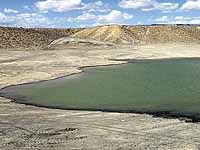| Pond two of the system will be the workhorse in regulating the water flow. |
The Lawrence South irrigation project is in its last phase. Carl Fillmore, project coordinator said, “This is a bureau of reclamation project funded through the salinity act. We have 28 members in our group. A lot of the people have their sprinklers in and ready and some still have some work to do. Most of the farmers are installing the wheel line sprinklers, but there are some with pivots or both. The pivot is 15 percent more efficient than the wheel line depending on how it’s used.
“From the Dick Allen Hill on down everybody is on the line. Some of the people were skeptical at first, but we worked to show them the benefits and brought them on board.
“We have valves that control the water in the ponds; one of the ponds is finished and the other is nearing completion. The input line is a 24 inch pipe and the output is a 27 inch line. It is a pressurized system. The land out here underwent a GPS survey to determine the best location for the retention ponds. Every foot of elevation will increase the water pressure. Harward Contractors from Springville designed the system and our contractors are doing the installation to their specifications,” said Fillmore.
Fillmore explained that the water will flow into a settlement, cleanup basin where the water will settle before it flows into the lines of the system. Each of the water intakes will also be covered with a big screen five and one half feet tall that will filter out further contaminants. A four inch stock watering line is also being installed along in the same corridor with the water lines.
The ponds have both been built to safety specifications to make them safe and without seepage. Soil in the surrounding area was tested and the soil for the ponds was taken from the location where it met the requirements. Pond two will be the workhorse of the system in water regulation.
| Workers install pipe at the water outlet structure. |
With the pressurized system it will be filled slowly and then kept full. Fillmore estimates they are two-three weeks away from completion. The ponds will be finished and some main line also needs to be installed. The system will be checked for leaks after it is filled. Water meters still need to be installed at each distribution point along the system. One third of the water in a canal system is lost through seepage. There are also canal lining projects going on in the county at this time.
Currently, the farmers along the Lawrence South project are getting ready to plant; but they will have to wait to water their fields until the system is completed. Fillmore said he has been told that they will be able to basically irrigate twice as much ground with the same amount of water. He said he is happy and it is an excellent system. “The sprinklers will stretch the water and I’ll be glad when we’re to that point,” said Fillmore. Ditches will come to an end with the newly installed irrigation system and the farmers will be able to reclaim and square up their fields. They also won’t have the wear and tear on equipment going through furrows in the fields. Fillmore said the plants will be healthier because flood irrigation stresses plants with too much water and then the wait between waterings stresses them with too little water.
The bureau of reclamation funds the pipeline to the property owners land. NRCS funding helps the landowner with his expenses on a 75/25 split and loan packages are available. Fillmore credits many people for the Lawrence South project. It is the result of many hours of hard work and dedication. Brett Behling was instrumental in the application process for funding. Those involved in the Ferron irrigation project were very helpful in relating their experiences and giving advice on do’s and don’ts along the way. He also said that PacifiCorp was cooperative, because they like to see these small irrigation projects going in.
The bureau is also leaning towards smaller irrigation projects which have less risk. The bureau has discovered the value in stopping the salt contamination of the Colorado River farther upstream and has spent a great deal of money on irrigation projects.

